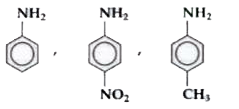Arrange the following in increasing order of their basic strength.
C2H5NH2,C6H5NH2,NH3,C6H5CH2NH2and(C2H5)2NH.
To arrange the given compounds in increasing order of their basic strength, we need to analyze the structure of each compound and understand the factors that influence basicity in amines.
Step 1: Identify the Compounds
The compounds given are:
1. Ethylamine (C₂H₅NH₂)
2. Aniline (C₆H₅NH₂)
3. Ammonia (NH₃)
4. Benzylamine (C₆H₅CH₂NH₂)
5. Diethylamine ((C₂H₅)₂NH)
Step 2: Understand Basicity in Amines
Basicity in amines is influenced by the availability of the lone pair of electrons on the nitrogen atom for protonation. Factors affecting basicity include:
- Inductive effects (electron-donating or withdrawing groups)
- Resonance effects (delocalization of lone pair)
- Steric hindrance
Step 3: Analyze Each Compound
1. Ethylamine (C₂H₅NH₂): It is an aliphatic amine with an electron-donating ethyl group, which increases the electron density on nitrogen, enhancing its basicity.
2. Aniline (C₆H₅NH₂): The lone pair on nitrogen is delocalized into the benzene ring due to resonance, which decreases its basicity compared to aliphatic amines.
3. Ammonia (NH₃): It has no alkyl groups to donate electron density, making it less basic than ethylamine but more basic than aniline.
4. Benzylamine (C₆H₅CH₂NH₂): The benzyl group (C₆H₅CH₂-) has a slight electron-donating effect compared to aniline, making it more basic than aniline but less than ethylamine.
5. Diethylamine ((C₂H₅)₂NH): With two ethyl groups, it has a stronger electron-donating effect, making it the most basic among the given compounds.
Step 4: Arrange in Increasing Order of Basic Strength
Based on the analysis:
1. Aniline (C₆H₅NH₂) - Least basic due to resonance.
2. Ammonia (NH₃) - Moderate basicity.
3. Benzylamine (C₆H₅CH₂NH₂) - More basic than ammonia due to slight inductive effect.
4. Ethylamine (C₂H₅NH₂) - More basic due to electron-donating ethyl group.
5. Diethylamine ((C₂H₅)₂NH) - Most basic due to two electron-donating ethyl groups.
Final Order
Increasing order of basic strength:
C₆H₅NH₂ < NH₃ < C₆H₅CH₂NH₂ < C₂H₅NH₂ < (C₂H₅)₂NH
The compounds given are:
1. Ethylamine (C₂H₅NH₂)
2. Aniline (C₆H₅NH₂)
3. Ammonia (NH₃)
4. Benzylamine (C₆H₅CH₂NH₂)
5. Diethylamine ((C₂H₅)₂NH)
Basicity in amines is influenced by the availability of the lone pair of electrons on the nitrogen atom for protonation. Factors affecting basicity include:
- Inductive effects (electron-donating or withdrawing groups)
- Resonance effects (delocalization of lone pair)
- Steric hindrance
1. Ethylamine (C₂H₅NH₂): It is an aliphatic amine with an electron-donating ethyl group, which increases the electron density on nitrogen, enhancing its basicity.
2. Aniline (C₆H₅NH₂): The lone pair on nitrogen is delocalized into the benzene ring due to resonance, which decreases its basicity compared to aliphatic amines.
Based on the analysis:
1. Aniline (C₆H₅NH₂) - Least basic due to resonance.
2. Ammonia (NH₃) - Moderate basicity.
3. Benzylamine (C₆H₅CH₂NH₂) - More basic than ammonia due to slight inductive effect.
4. Ethylamine (C₂H₅NH₂) - More basic due to electron-donating ethyl group.
5. Diethylamine ((C₂H₅)₂NH) - Most basic due to two electron-donating ethyl groups.
Increasing order of basic strength:
C₆H₅NH₂ < NH₃ < C₆H₅CH₂NH₂ < C₂H₅NH₂ < (C₂H₅)₂NH
Topper's Solved these Questions
- ORGANIC COMPOUNDS CONTAINING NITROGENBOOK - PRADEEPCHAPTER - ORGANIC COMPOUNDS CONTAINING NITROGENEXERCISE - COMPETITION FOCUS JEE (MAIN AND ADVANCED)/MEDICAL ENTRANCE SPECIAL (VII. ASSERTION-REASON TYPE QUESTIONS) TYPE - II
9 Videos
- HALOALKANES AND HALOARENESBOOK - PRADEEPCHAPTER - HALOALKANES AND HALOARENESEXERCISE - IMPORTANT QUESTIONS FOR BOARD EXAMINATION
22 Videos
- P-BLOCK ELEMENTS BOOK - PRADEEPCHAPTER - P-BLOCK ELEMENTS EXERCISE - IMPORTANT QUESTIONS FOR BOARD EXAMINATION
25 Videos
Similar Questions
Arrange the following in increasing order of their basic strength:
(i) C2H5NH2,C6H5NH2,NH3,C6H5CH2NH2and(C2H5)2NH
(ii) C2H5NH2,(C2H5)NH,(C2H5)3N,C6H5NH2
(iii) CH3NH2,(CH3)2NH,(CH3)3N,C6H5CH2NH2.
View SolutionArrange the following in increasing order of their basic strength:
(i) C2H5NH2,C6H5NH2,NH3,C6H5CH2NH2and(C2H5)2NH
(ii) C2H5NH2,(C2H5)2NH,(C2H5)3N,C6H5NH2
(iii) CH3NH2,(CH3)2NH,(CH3)3N,C6H5CH2NH2.
View SolutionArrange the following in increasing order of their basic strength :
(i) C2H5NH2,C6H5NH2,NH3,C6H5CH2NH2 and (C2H5)2NH (ii) C2H5NH2,(C2H5)2NH,(C2H5)3N,C6H5NH2
(iii) CH3NH2,(CH3)2NH,(CH3)3N,C6H5NH2,C6H5CH2NH2
View SolutionArrange the following in increasing order of their basic strength :
(i) C2H5NH2,C6H5NH2,NH3,C6H5CH2NH2 and (C2H5)2NH.
(ii) C2H5NH2,(C2H5)2NH,(C2H5)3N,C6H5NH2.
(iii) CH3NH2,(CH3)2NH,(CH3)3N,C6H5NH2,C6H5NH2.
View SolutionArrange the following in increasing order of their basic strength :
(i)C2H5NH2,C6H5NH2,C6H5CH2NH2 and (C2H5)2NH
(ii) C2H5NH2,(C2H5)2NH,(C2H5)3N,C6H5NH2
(iii) CH3NH2,(CH3)2NH,(CH3)3N,C6H5NH2,C6H5CH2NH2
View SolutionArrange the following in decreasing order of their basic strength :
C6H5NH2,C2H5NH2,(C2H5)2NH3
View SolutionArrange the following in decreasing order of their basic strength :
C6H5NH2,C2H5NH2,(C2H5)2NH3
View SolutionArrange the following in incresing order of basic strength :
C6H5NH2,C2H5NHCH3,C6H5N(CH3)2.
View SolutionArrange the following in increasing order basic strength :
(i) C6H5−NH2,C6H5CH2−NH2,C6H5NH−CH3
(ii)
View SolutionRerrange the following in an increasing order of their basic strengths:
C6H5NH2,C6H5N(CH3)2,(C6H5)2 NH and CH3NH2.
View Solution
